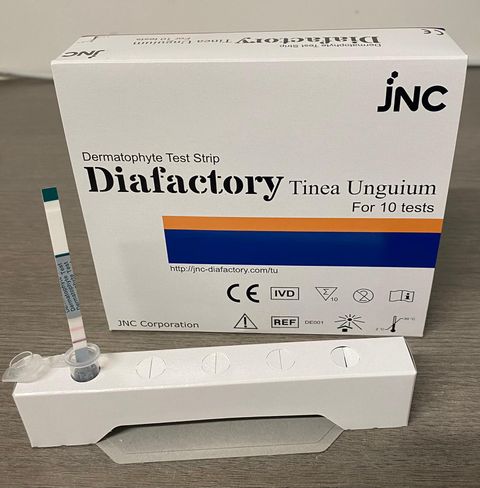Introducing the 5 minute in-clinic fungal nail test, now available at The Podiatry Practice in Brisbane.

If you or a loved one has ever had a discoloured nail you may know that testing for fungus is a tricky task. It usually involves your podiatrist taking a specimen, making an appointment with the GP for a referral, taking your referral and specimen to a testing centre, and then waiting 6 weeks for results. Unfortunately there is also a high ‘false negative’ rate (up to 40%) with this form of testing, which can confuse treatment.
Here at The Podiatry Practice, we are always striving for innovative diagnostic and treatment options to ensure the best solutions for our patients. That is why we are excited to introduce the Diafactory Dermatophyte Test Strip, an 5 minute in-clinic test for onychomycosis (fungal infection of the nail).
The in-clinic test is designed to test for 8 of the most common organisms present in fungal nails, and will enable your Podiatrist to more accurately diagnose a fungal infection and provide treatment during your appointment.

Features/Benefits:
- 97% accurate
- Detects 99% of all common dermatophytes (most common infecting organism in fungal nails)
- No need to send nail scraping to a lab or have multiple appointments (podiatrist, GP etc)
- Allows greater confidence in treatment of troublesome infections
A little bit more about fungal nails… How do they happen?
Fungal infections tend to affect the exterior surfaces of the foot – the skin and nails. Because most people wear closed in footwear regularly, this provides the perfect environment for fungal infection – a warm, dark place. Whereas skin surfaces exposed to ultraviolet radiation from sunlight (eg arms and legs), are far less prone.
Fungal nail infections are a common cause of concern for our patients. These infections often cause a yellow-ish discolouration in the nail plate, and often thickening and deformity. Although these infections don’t generally cause any great problems in their own right, they do cause embarrassment for many people. If the infection causes deformity to the nail plate – this can cause secondary pain and discomfort which might need to be addressed.
Once diagnosed, how are they treated?
Fungal nail infections can be very stubborn to treat and cure, so beware of advertising claims that suggest these infections can be easy to eradicate. Because the infection resides within and underneath the nail plate, it is often difficult for topical antifungal preparations to adequate penetrate and kill off the fungal spores. Where an infection is confined to the end part of the nail, we will often remove the infected area of nail (which is usually painless), to allow for topical treatments to be more effective. However, when the infection has spread to the base of the nail and affects the nail root, topical treatments are generally considered ineffective.
We recommend that more severe fungal nail infections generally require oral antifungal medications to treat the problem successfully. Usually a course of oral terbinafine is recommended for at least 12 weeks to treat the infection, and for new healthy nail to begin to grow out. However, some patients may not be suited to this medication, and cannot take this option. According to current evidence, the use of laser therapies to treat significant fungal nail infections is still inconclusive, so it is difficult at this time for us to support this quite costly approach.
In some rarer cases of stubborn infection which has been resistant to all other types of treatment, we occasionally suggest surgical removal of the nail plate, which can be either a temporary or permanent option.
Do you or a family member have a suspected fungal nail? Visit one of our friendly Podiatrists to find out more. Call us on 3391 3900 or book online today.




